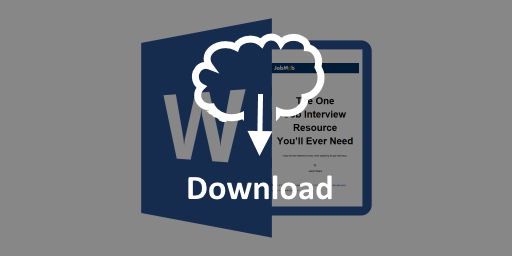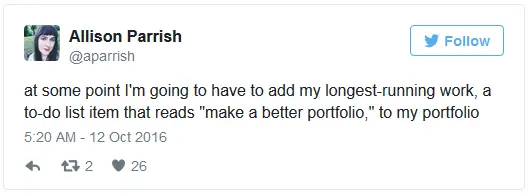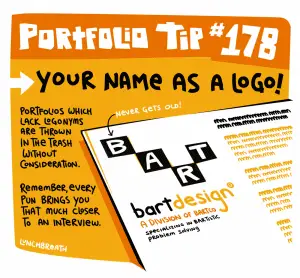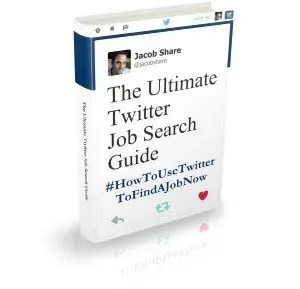Have a proven track of success? Wow recruiters by bringing the proof to job interviews.

This is a guest post by Debra Wilson.
3 Reasons to Have a Work Portfolio
You might feel a little strange compiling a work portfolio (aka a career portfolio), especially if you have to fill it with rather abstract reports and things, which you might if you’re in a certain type of work. However, there are lots of great reasons to have a work portfolio.
Free bonus: The One Job Interview Resource You’ll Ever Need is a handy reference to help you prepare for any kind of job interview. Download it free now
Here are just a few:
1) To solidify your resume
The actual process of making a portfolio helps you find out what you’ve actually done in your work so far – whether you’re still in college or have been in the work force for years.
By creating a portfolio, you can find more concrete accomplishments to list on your resume. Even if you don’t use it for every job interview, you’ll still have a more polished resume to present to potential employers.
2) To make a good impression
Having a portfolio at an interview makes you seem more put-together and prepared, which is impressive for potential employers.
3) To build your credibility
A portfolio is also excellent for lulls in an interview or for giving interviewers concrete answers to their questions. For instance, when asked what experience you have in your particular profession, you can pull out a report or give concrete statistics about what you’ve done.
Notice how the word “concrete” has come up a couple of times in this list?
Having real items to show potential employers, whether they are reports that you have actually written, statistics about your job performance, or samples of projects you’ve been a part of, can help employers understand the value of what you can bring to a work team.
What is a Work Portfolio, Anyway?
Now, you might be wondering what exactly a portfolio is.
When you hear the word, you think about art projects or slides that a graphic designer might display. Your portfolio doesn’t have to be anything like that. All it needs to be is a folder full of samples of your work. It can include photos, reports, brochures, lists of statistics, and anything else you can think of.
All a work portfolio needs to be is a folder full of samples of your workClick To TweetFor example, if you were involved in the planning of a major event at a theater, you can include a brochure for that event. Even if you did not work directly on the brochure, you can use it as a concrete reminder of what you did do during that project, so you can bring that up in interviews.
As long as everything in your portfolio ties in directly to your work experience and offers logical glimpses into your work experience, you’ll be helping yourself by putting one together.
5 Tips for Creating and Using a Portfolio
There are all sorts of ways to make your portfolio unique. Some people have both hard copies and a PowerPoint presentation saved on a disc or USB thumb drive.
The key is to make sure your portfolio is organized and neat looking. If you’re in a field like graphic design or advertising, you’ll also want it to be visually attractive. In other fields that rely less on visual arts, just make sure that it’s neat and easy to navigate.
Here are some tips for creating and using your work portfolio:
1) Never assume you don’t have enough to fill a portfolio
Even college students can include transcripts, letters of recommendation from professors, and even college papers on work-related topics.
2) Include anything positive
Include performance reviews from former bosses, copies of certificates for training and awards, writing samples, design samples, testimonials from clients, a list of your accomplishments, a list of things you can do that aren’t necessarily on your resume, and your complete resume. In this instance, your resume can spill over the standard one-page, and can be more like two pages.
3) Formatting counts
Put a table of contents at the beginning of your portfolio, and number the pages so that you and potential employers can navigate it easily.
4) Use a three-ring binder with plastic page covers for your portfolio
This allows you to keep different-sized sheets of paper together, and it allows you to rearrange or add to your portfolio over time. This way, you don’t have to re-create it every time you have new things to add.
5) Take your portfolio to every interview
You don’t always need it, but you should definitely have it with you. If you think it’s a really great way to connect with interviewers, make it conspicuous when you walk in. Many interviewers will ask what you have with you when they see it. If you’re a little less confident, leave it tucked away, and only pull it out if you know you can use it to answer a question more fully.
Putting together a work portfolio can take time, but it can also be an excellent way to set yourself apart from the crowd during an interview.
If you’re nervous during your interview, it may help you feel more confident. Instead of stuttering around trying to explain your work experience, you can pull out your portfolio and have concrete examples of your work to guide your interviewer’s questions and your own answers throughout the interview.
Sample work portfolio for any profession
Wondering what a work portfolio looks like?
Here's one example of a work portfolio binder to bring to job interviews that you can use as an interview portfolio template:
Free BonusIf you want a handy job interview resource that you can keep on your smartphone or print out for easy reference, I’ve got a special bonus for you.
This free download contains:- 165 positive personality adjectives to describe yourself
- 444 of the most popular job interviewer questions to prepare yourself with
- 175 questions that you can ask in job interviews to make a good impression and learn about your future employer

JobMob Insiders can get this free bonus and other exclusive content in the JobMob Insider Bonuses area. Join now, it's free!
READ NEXT
Wondering how to make an online work portfolio? Check out 115+ Resources for Showing Off Your Work Skills
Are you creative and handy with graphic design tools? Stand out with the one page resume work portfolio
About the author
Debra Wilson is a social media advocate at the business credit cards comparison website CreditDonkey.
Subscribe to JobMob via RSS or email and follow me on Twitter for more great job interview tools.




I have had a work portfolio for many years and am most proud of the customer feedback I display in it.
Shelby- that’s smart. Where did you get the idea to do a work portfolio in the first place?
Jacob – I honestly don’t remember! I did workshops on creating & using them in job search & for career development purposes. My background is law so I used the approach of “presenting your evidence”.
Great blog! I have been building my non profit fund development portfolio for over 15 years and I agree it’s supports your “viability” when applying for a position and attending an interview. By personally pointing out certain items in your portfolio, makes great opportunity of “breaking the ice” and making it more “personal” between you and the interviewer.
The only challenge is that my portfolio is getting quite large now and I can’t find a binder larger that 3inches wide, to fit it all in 🙂 Any advice what to use.
As someone who has had to look at many candidate’s portfolios in interviews, I would say “less is more”. Please don’t take a 3″ binder into an interview. Customize your portfolio for the specific position. You can let them know that you have additional samples of your work that you can share with them after the interview if they are interested.
Pingback: 7 Job Trends That You Need to Know About | JobMob
Pingback: How To Make an Impact in The First Interview | JobMob
Pingback: 7 trends that have changed the world of work and how to adapt | CareerFolk
Pingback: The Best Pinterest Job Search Tips From The Experts | JobMob
Pingback: Become Your Own Job Creator in 10 Simple Steps | Motivational Tools. Inspirational Blogs. Community.
Pingback: 5 Ways To Massively Crowdsource Your Job Search | JobMob
Pingback: Become Your Own Job Creator in 10 Simple Steps | CareerFolk
Pingback: Stand Out With The One Page Resume Work Portfolio | JobMob
Pingback: Top 100 Pinterest Boards for Job Search » CPG Jobs
Pingback: #CONTEST: Leave a Comment, Win Professional Video Resume Help | JobMob
Pingback: 114 Resources for Showing Off Your Work Skills | JobMob
Pingback: What’s The Difference Between CVs, Resumes and Curricula Vitae? | JobMob
Pingback: Jobberman Insider | The Job Interview Tool You Are Not Using.
Pingback: Top 100 Pinterest Boards for Job Search | JobMob
Pingback: Episode 021 - Expert Series : Jacob Share from JobMob
Good idea but…How do you manage to build up a portfolio if your employer own all the immaterial rights of the material you produce?
Great question, Lari. I’m not a lawyer, the law may be different where you are, and every situation can be unique, so I’m not going to try a definitive answer other than to say that if you think it’s relevant in your case, ask a lawyer.
That said, there are a number of ways of dealing with this.
Anything confidential or secret obviously shouldn’t be included without unequivocal permission. However, if information has already been made public by your employer, you should be in the clear.
Your employment contract may have a clause regarding use of work.
Ideally, you compile/add to your work portfolio while on the job, after achievements, recognition, etc. This way, you’re less likely to forget something than if you tried to look back later. Also, that’s when you still have access to all the information you need.
Depending on your experience with a company, you’ll probably get a good idea of what you can and cannot divulge, but if you’re not sure what you can discuss publicly, ask your boss. It also doesn’t need to be all or nothing; documents and images can be redacted if necessary.
Regardless of whether you’ve asked in the past, use your exit interview to make sure any portfolio inclusions are ok.
If you leave an employer on good terms, you should also be able to contact them later for clearance if necessary.
Pingback: � The Best Free Job Interview Tool You'r...
Pingback: 25 Things To Do Before Leaving Work for the Last Time | JobMob
Pingback: 🔨 How Older Job Seekers Beat These 15 Awful Stereotypes | JobMob
Pingback: 6 Reasons You Need A Smartphone To Job Search
Pingback: 🤖 Is My Job Going To Be Automated?
Pingback: 🗺 47 Awesome Resume Mind Map Ideas to Copy
Pingback: 📇 Why Job Seekers Need Business Cards
Pingback: 🎥 Top Useful Ways Job Seekers Are Using Video Today
What about e-Portfolios?
What about them, Dawn?
Pingback: 💻 How These Smart Job Seekers Used Blogging To Find Jobs
Pingback: 🙋♀️ How To Keep In Touch Professionally With Your LinkedIn Connections
I really like this idea and since it’s not too common, it’s a good way to stand out from the crowd.
In this day and age, people don’t have time (or inclination) to read anything long…Do employers out there appreciate seeing – and reading – a job portfolio?
You would normally bring the work portfolio to job interviews (binder/on your phone/USB key) to reference while responding to questions and telling stories. Employers definitely appreciate seeing you back up your words.
For virtual interviews, you can send it over beforehand with a note saying that you’re going to refer to it during the interview. Some recipients will be curious enough to peek at it and even prepare questions about what they see there.
You could also make it downloadable or viewable from your personal website or social profiles that you’re using to build your personal brand while showing off your work expertise.
Pingback: How to Succeed in a Job Interview - WEmng
Pingback: 💻 How To Prepare For Virtual Job Fairs